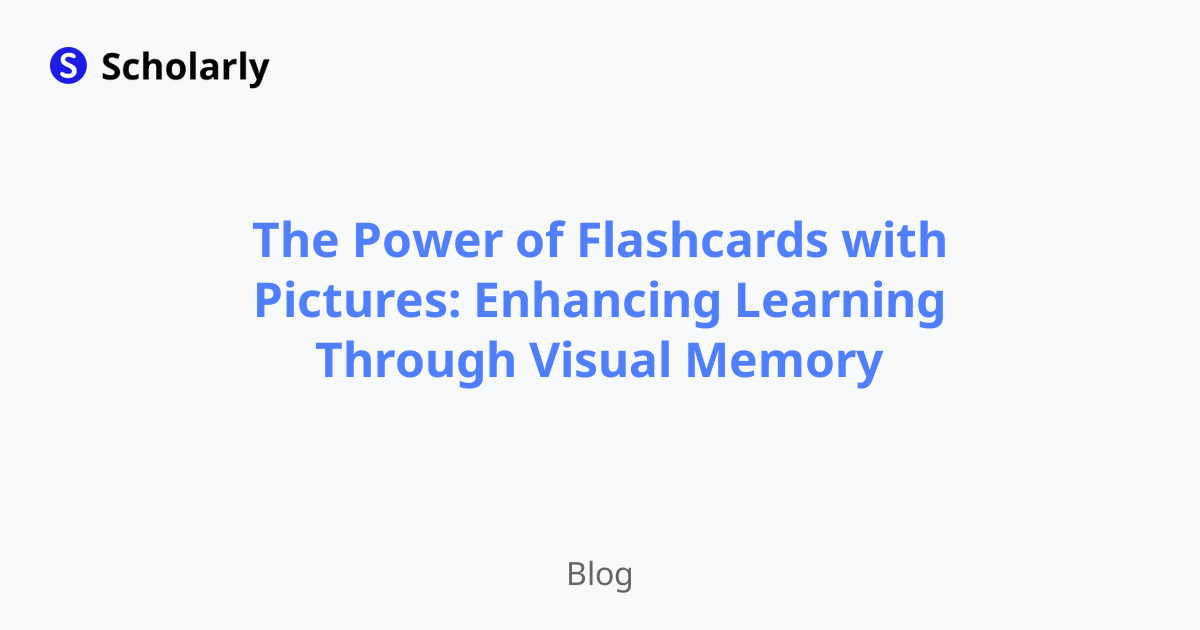The Power of Flashcards with Pictures: Enhancing Learning Through Visual Memory
Discover how incorporating pictures in flashcards can improve memory retention and accelerate learning.

Introduction
In the realm of effective learning strategies, flashcards have long been hailed as a valuable tool for retaining and recalling information. Flashcards engage active recall, a method proven to enhance memory, comprehension, and long-term retention. Traditionally, flashcards consist of text-based prompts and corresponding answers or definitions. However, by integrating pictures into flashcards, learners can tap into the power of visual memory and supercharge their learning experience.
The Benefits of Flashcards with Pictures
Flashcards with pictures offer numerous advantages that make them an invaluable asset for learners of all ages and across various subjects. Let's delve into the benefits they provide:
Enhanced Memory Retention: Visual stimuli have a profound impact on memory recall. When learners associate an image with a concept or fact, they create a lasting connection between the visual cue and the information, leading to improved retention.
Deeper Comprehension: Pictures can convey complex ideas or relationships that might be difficult to articulate through words alone. By representing information visually, learners can develop a deeper understanding of abstract concepts or intricate details.
Increased Engagement and Motivation: The inclusion of pictures in flashcards adds an element of visual interest, making the learning process more engaging and enjoyable. This enhanced engagement can boost motivation and encourage learners to spend more time studying.
Contextualization and Real-World Application: Pictures allow learners to contextualize information and visualize how it applies in real-world scenarios. By connecting abstract concepts to tangible representations, learners can grasp the practical implications of the knowledge they are acquiring.
Multi-Sensory Learning: Incorporating visuals into flashcards taps into the power of multi-sensory learning, engaging both visual and verbal memory systems. This enhances the encoding and retrieval process, leading to more robust learning outcomes.
Best Practices for Creating Flashcards with Pictures
To maximize the effectiveness of flashcards with pictures, here are some best practices to keep in mind:
Choose Relevant and Clear Images: Select images that directly relate to the concept or information being learned. Make sure the images are clear, well-cropped, and visually appealing to optimize comprehension and retention.
Use Mnemonics and Associations: Leverage mnemonic devices or create associations between the picture and the content to enhance memorization. Mnemonics help trigger memory recall by linking vivid mental images or visual cues to specific information.
Balance Visual Stimuli with Text: While pictures are powerful memory aids, it is essential to find a balance between visual stimuli and accompanying text. Use concise and well-crafted text to reinforce the key points or concepts depicted in the images.
Organize Flashcards by Themes or Categories: Grouping related flashcards with pictures together can facilitate learning and reinforce connections between concepts. This strategy promotes the formation of mental frameworks and aids in comprehensive understanding.
Incorporate Progression and Complexity: Start with simple images and gradually introduce more complex visuals as learners progress. This incremental approach allows for the gradual development of comprehension and prevents overwhelming learners with intricate details from the start.
Pros and Cons of Flashcards with Pictures
While flashcards with pictures offer significant benefits, it is essential to consider both the pros and cons before incorporating them into your learning routine:
Pros:
- Enhanced memory retention through visual association
- Deeper comprehension of complex concepts
- Increased engagement and motivation
- Contextualization and real-world application of knowledge
- Multi-sensory learning for improved encoding and retrieval
Cons:
- Time-consuming image selection and editing
- Limited applicability for certain subjects without visual components
- Potential distraction if images are not carefully chosen or relevant
- Additional effort required in creating and organizing visual content
- Possibility of over-reliance on pictures instead of fostering deeper understanding
Exploring Online Tools for Flashcards with Pictures
In today's technology-driven era, online tools offer a range of features to enhance the creation and utilization of flashcards with pictures. Here are some popular options:
Anki: Anki is a widely-used flashcard application that allows users to create flashcards with both text and images. It offers customizable settings and utilizes a spaced repetition algorithm to optimize learning.
Quizlet: Quizlet is a comprehensive learning platform that enables users to create visually-rich flashcards. With its vast library of user-generated content, Quizlet offers access to a wide range of pre-existing flashcards with pictures.
Cram.com: Cram.com provides a user-friendly interface for creating flashcards with pictures, allowing learners to customize their cards and collaborate with peers. It also offers a variety of study modes, including games and practice quizzes.
Memrise: Memrise combines flashcards with mnemonic techniques and pictures to enhance vocabulary acquisition and language learning. Its gamified approach and interactive features make the learning process engaging and enjoyable.
Scholarly: Scholarly is an AI-powered platform that revolutionizes flashcard creation and learning. It leverages AI-generated text completion, flashcard creation, and auto-complete to streamline the learning experience and accelerate knowledge acquisition.
Conclusion
By incorporating pictures into flashcards, learners can tap into the power of visual memory and unlock new dimensions of learning. The benefits of flashcards with pictures, such as enhanced memory retention, deeper comprehension, and increased engagement, make them an indispensable tool in any learner's arsenal. With the proliferation of online tools designed to facilitate the creation and utilization of flashcards with pictures, the path to accelerated learning and knowledge acquisition has never been clearer. Embrace the potential of visual memory and embark on a learning journey that combines the best of both words and images.
Try Our Popular AI Study Tools
Transform your study materials into interactive learning experiences with our most popular AI-powered tools:
PDF to Flashcards
Convert lecture notes and textbooks into study flashcards instantly
Text to Flashcards
Turn any text or notes into comprehensive flashcard sets
Image to Flashcards
Convert diagrams and handwritten notes into digital flashcards
YouTube to Flashcards
Generate flashcards from educational video content



